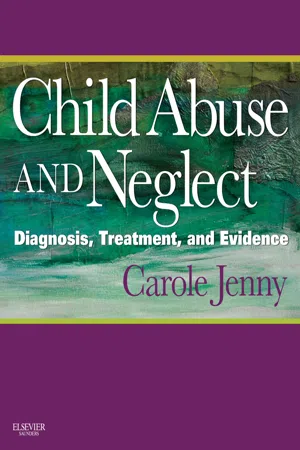![]()
V
Physical Abuse of Children
![]()
26 Documenting the Medical History in Cases of Possible Physical Child Abuse
Allison M. Jackson, MD, MPH, Brian M. Jackson, MD
The clinician’s responsibility to document cases where child abuse is in the differential diagnosis is a critical aspect of providing effective patient care. The medical record can serve as an important tool for ensuring the immediate safety of the child and ongoing effective medical care. The medical record should be complete and thorough to provide the maximum benefit to those treating and safeguarding the child.
For years it has been known that the answer to the patient’s medical condition is usually revealed by a comprehensive medical history.1,2 Child physical abuse is no exception. The history is usually provided by the parent or caregiver, particularly when a child is preverbal or too ill to speak.3 While a third party history is the norm in pediatric care, when possible a history should also be obtained from the child. Unlike other medical conditions, nonmedical professionals are often involved in obtaining historical information in cases of suspected abuse. The medical history, however, serves as a separate record from that obtained by nonmedical investigators. It is important that the medical record be unbiased. When documenting physical abuse of children, the clinician should maintain the attitude of a scientist and educator. The clinician is not a “child advocate” in terms of the individual case.4 The patient will be best served when the medical record is unbiased, fact-oriented, and formatted to provide the best medical care for the child.
Recent studies have confirmed that current documentation practices in cases of suspected child abuse are often inadequate, lacking details about how the injury occurred, when and where the injury occurred, if witnesses were present at the time of the injury, the child’s developmental abilities at the time of injury, and descriptions of past injuries.5,6 Two studies from U.S. emergency departments showed medical records to be incomplete in at least one third of cases where abuse was suspected. While most clinicians effectively document the victim’s age, injury type, and child protective services (CPS) involvement, few appropriately documented a developmental history, included an illustration of the injury location, or noted the presence of witnesses to the injury.6-9 A comparison to documentation in 1980 showed minimal improvement in charting despite increased efforts to train clinicians.6 A comparable Australian study of fractures in the emergency department found similar deficiencies.10 There is a clear need for improved documentation of these cases.
The medical record is not only a means of communication among medical providers, but is also a legal document. Proper documentation is therefore important for several reasons. It records victims’ statements for legal proceedings. The judicial system uses the medical history as recorded in the medical record as a factor in weighing the credibility of a child witness.11 In most jurisdictions, a child’s statement to an adult is hearsay and therefore inadmissible in legal proceedings. An exception often exists for statements made to medical professionals, exercised at the discretion of the presiding judge. One factor judges consider is whether the physician’s testimony about the child’s statement is consistent with the medical record.12 Sometimes a complete medical record will allow a clinician to testify in place of a child, sparing the child significant emotional and psychological trauma.10
While physician testimony can be critical in child abuse cases, an adequate record often prevents the need for the physician to appear in court at all. Subpoenas for physicians are issued in about 15% of abuse cases, and physicians testify in fewer than 5% of cases.13 Clear and complete documentation can be used by the legal system in place of in-person testimony, particularly in pretrial and/or presettlement negotiations.14 Because physicians will not often testify in person in these cases, their documentation becomes extremely important.
Complete documentation helps prevent future episodes of abuse. Without clear documentation, it is difficult to distinguish abuse from nonabuse should the patient subsequently have a new complaint.15 A full record of information also enables accurate data collection for child maltreatment research.
The Medical Record
The Interview Circumstances
Before delving into the substance of the history, the clinician should document the circumstances under which the interview took place. Documentation begins with a notation of the date, time, and location of the interview. This allows for an impartial observer to determine the elapsed time between the injury and the interview, and also allows for a chronology of the caregiver and/or child’s statement. The reports in the medical record can be used in conjunction with police and social work reports. The time of documentation determines if the notes are contemporaneous. In general contemporaneous notes are considered more reliable than notes written after a significant amount of time has elapsed.16
The sources of the history should include the child, if developmentally and medically capable, and the parents/caregivers. Additional sources for the history might include other medical personnel, such as emergency medical services providers, nurses, and primary and specialty care providers. These professionals’ documentation can be informative and should be included, when available, in the medical record. Thus clinicians should document the source(s) of the history and whether the participants were interviewed together or separately. If law enforcement, child protective services (CPS), or other personnel are present, this should be noted as well. Because the clinician’s interview is primarily for medical purposes, statements made to medical staff alone are often given more weight in court than statements made to law enforcement or CPS. It may be useful to document the history from each historian separately, just as they should be interviewed separately.
Demog...
